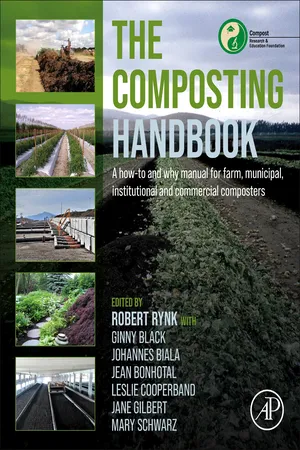
The Composting Handbook
A how-to and why manual for farm, municipal, institutional and commercial composters
- 1,002 pages
- English
- ePUB (mobile friendly)
- Only available on web
The Composting Handbook
A how-to and why manual for farm, municipal, institutional and commercial composters
About This Book
The Composting Handbook provides a single guide to the science, principles and best practices of composting for large-scale composting operations facing a variety of opportunities and challenges converting raw organic materials into a useful and marketable product.
Composting is a well-established and increasingly important method to recycle and add value to organic by-products. Many, if not most, of the materials composting treats are discarded materials that would otherwise place a burden on communities, industries, farms and the environment. Composting converts these materials into a valuable material, compost, that regenerates soils improving soils for plant growth and environmental conservation.
The Composting Handbook expands on previously available resources by incorporating new information, new subjects and new practices, drawing its content from current scientific principles, research, engineering and industry experience. In both depth and breadth, it covers the knowledge that a compost producer needs to succeed. Topics include the composting process, methods of composting, equipment, site requirements, environmental issues and impacts, business knowledge, safety, and the qualities, uses and markets for the compost products.
The Composting Handbook is an invaluable reference for composting facility managers and operators, prospective managers and operators, regulators, policy makers, environmental advocates, educators, waste generators and managers and generally people interested in composting as a business or a solution. It is also appropriate as a textbook for college courses and a supplemental text for training courses about composting or organic waste management.
- Created in conjunction with the Compost Research and Education Foundation (CREF)
- Includes the latest information on composting and compost, providing the first comprehensive resource in decades
- Written with focus on both academic and industrial insights and advances
Frequently asked questions
Information
Table of contents
- Cover image
- Title page
- Table of Contents
- Copyright
- Dedication
- Authors and Contributors
- Preface
- Acknowledgments and appreciations
- Chapter 1. Why compost?
- Chapter 2. Enterprise planning
- Chapter 3. The composting process
- Chapter 4. Compost feedstocks
- Chapter 5. Passively aerated composting methods, including turned windrows
- Chapter 6. Forced aeration composting, aerated static pile, and similar methods
- Chapter 7. Contained and in-vessel composting methods and methods summary
- Chapter 8. Composting animal mortalities
- Chapter 9. Composting operations and equipment
- Chapter 10. Site planning, development, and environmental protection
- Chapter 11. Process management
- Chapter 12. Odor management and community relations
- Chapter 13. Safety and health principles and practices for composting facilities
- Chapter 14. Facility management
- Chapter 15. Compost characteristics and quality
- Chapter 16. Compost use
- Chapter 17. Compost use for plant disease suppression
- Chapter 18. Compost marketing and sales
- Chapter 19. Composting economics
- Appendices
- Sources of photographs and external graphics
- Index